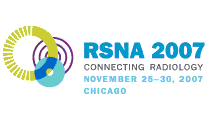
Abstract Archives of the RSNA, 2007
Jason Cordell Birnholz MD, Presenter: Nothing to Disclose
Embryonic age is estimated ultrasonically from body (i.e. crown rump) length (EL), which may be difficult to measure precisely when length is a low multiple of wavelength. Heart rate (HR) increases with length and with conceptual age during the first two months of pregnancy. We have studied the relation between HR and EL during this epoch and wish to report normative observations.
EL is determined prospectively for 818 intrauterine pregnancies with embryoes (2) with minimal length gate centered in the chest.
Cardiac activity is visible as early as an embryonic pole can be discerned. HR increases rapidly from 60 at 0.6mm EL to 110 at 2.0mm EL and almost linearly thereafter to 175 at 20mm EL. EL and HR are highly correlated (r2=.93). When EL is transformed to embryonic age using published data, HR and conceptual age are fit with a family of equations having r2=.95. Log (HR)and Log(EV) have a near linear relation over this conceptual age range.
Under routine imaging conditions, early embryonic heart rate can be determined with greater precision than body length. These data indicate that conceptual age can be estimated accurately from HR. HR is an indicator of cardiac output in the early embryonic period, since there is little variation in stroke volume during this phase of development. When EL can be measured well, predictive information about depressed cardiac function may be derived from disparities between observed HR and EL values.
Heart rate appears to be an accurate determinant of conceptual age in early embryonic stages, when physical factors may impede imaging.
Birnholz, J,
Conceptual Age of Early Embryoes from Heart Rate. Radiological Society of North America 2007 Scientific Assembly and Annual Meeting, November 25 - November 30, 2007 ,Chicago IL.
http://archive.rsna.org/2007/5003449.html

